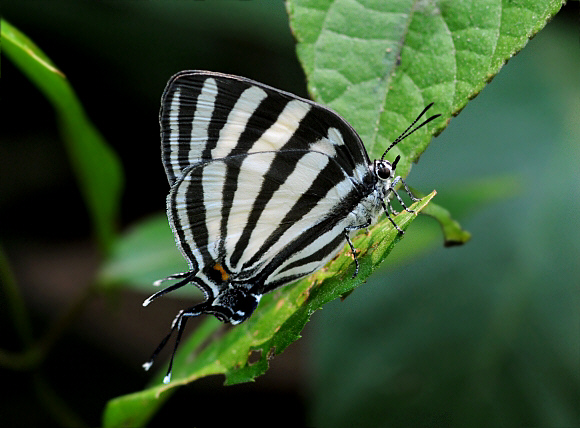
Introduction
Almost all neotropical Theclinae species are placed in the Eumaeini. The tribe is not particularly well represented in collections, so until fairly recently a high percentage remained unstudied, and were inappropriately filed away in the ‘convenience’ genus Thecla. Many taxonomists have attempted to rationalise the systematics of the Eumaeini, the most recent being Robbins who published a revision in 2004, reclassifying the taxa into 83 genera.
Currently there are 1058 known species. Taking into account their small size, secretive behaviour, and the great similarities between many species, it is estimated that about another 200 species probably remain to be discovered.
There are 8 species in the genus Laothus, found variously from Mexico to Brazil and Peru. All have a zebra-striped pattern on the underside. In half of these species the ground colour is brown, and the stripes are narrow and white. In numen, phydela, erybathis and gibberosa the white bands are very broad, giving the impression of a white ground colour with dark brown or blackish stripes.
The strong pattern serves to divert the eyes of predators away from the butterfly’s head and body, and towards the ‘false antennae’ tails. It creates a ‘back to front’ illusion that deceives lizards and birds, tricking them into aiming their attack the wrong part of the butterfly. The predators typically try to increase their chances of a direct hit by aiming their attack just ahead of where they expect the butterfly to fly, but are fooled into aiming behind, instead of in front of the target. The result is that the butterfly is able to make its escape in the opposite direction.
The costa of the forewings of gibberosa females is strongly bowed but in males is far more extreme, forming an extraordinary protuberance or ‘hump’. The purpose of this appears to be unknown, and would make a fascinating subject for research.
Laothus gibberosa is found in Colombia, Ecuador and Peru.
Habitats
This species is found in rainforest and cloudforest at altitudes between about 400-1800m on both sides of the Andes.
Lifecycle
To be completed.
Adult behaviour
This species is invariably encountered singly, perching or resting on foliage at light gaps or in small glades in the forest. Females in my experience are more frequently encountered than males.
